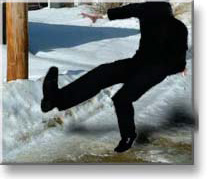November Safety Tip
Winter Safety Tips
Cool temperatures tend to creep up on us in the fall and early winter, and the potential hazards that winter weather can bring to your shop floor do the same. Here are five things to do that you might not think about to ready your facility this winter to keep your team safe and productive.
When making sure that workers are warm and comfortable as the winter months set in, safety teams must watch for specific winter dangers. They also need to assess their shop floors to identify less obvious potential risks.
Here are five winter safety tips to do right now to keep your workers safe and your plant productivity high.
Winter Safety Tip #1: Don’t overheat your manufacturing team in winter.
When temperatures drop and heating systems come on, there can be a tendency for the overall environment to become too warm.
While safety teams often worry about cold stress—particularly for any workers who must be outside, the overheating of the shop floor can create an uncomfortable environment for your machinists, who already may be wearing protective clothing, gloves and other personal protective equipment to avoid other hazards. PPE, while increasingly designed for worker comfort, still adds a layer of warmth. Plus, machines also generate heat.
When winterizing, the safety and facilities teams will want to make sure that the shop recalibrates HVAC settings to maintain the temperature range between 68 to 76 degrees and humidity between 20 percent to 60 percent, as recommended by the Occupational Safety and Health Administration in its Technical Manual.
Some shops run fans all year long to help maintain the right thermal environment and distribute heat generated by manufacturing operations.
There’s a productivity factor, too. Research by the International Centre for Indoor Environment and Energy in Denmark “indicated that improved thermal comfort, reduction in indoor pollutants and enhanced ventilation rates and effectiveness can increase productivity” by 5 percent to 10 percent, according to FacilitiesNet.
Keep an Eye Out for Cold Stress Symptoms
While at many manufacturing facilities most workers remain indoors year-round, it’s still important to know the signs of cold stress that can lead to dangerous hypothermia.
Cold temperatures, particularly when paired with high winds, can lead to quick drops in a person’s overall body temperature and put them at risk of hypothermia and possibly death.
Even in a manufacturing plant, workers might need to manage deliveries at a dock or do snow removal on walks and parking lots. You’ll want to protect these teams from harm.
Here are seven cold stress signs OSHA says to watch for:
- Body temperature drop to 95 degrees or less
- Alert but shivering
- Shivering that suddenly stops
- Confusion
- Slurred speech
- Slowed heart rate and breathing
- Loss of consciousness
Winter Safety Tip #2: Keep hydration stations full at all times.
Workers are less likely to think about needing to keep hydrated when cooler temperatures arrive. That’s true even if the temperatures remain consistent on the shop floor.
Be sure to continue to stock water and other hydration products at convenient stations around the shop floor. And probably most important, remind your workers to keep drinking fluids. Training and awareness matter, according to the medical research.
Here’s why. Psychologically, people think they’re less thirsty in winter. “In winter, people feel about 40 percent less thirsty, even though the body’s need for water is unchanged year-round,” according to research reported by the Summit Medical Group. “Because we don’t feel thirst as acutely as we do in summer, we’re less likely to keep a bottle of water handy during cold-weather months.”
Winter Safety Tip #3: Set up water management kits to keep rain and snow melt at bay.
When winter weather strikes, your shop floor has potential new sources of water—whether from rain and snow that comes off of workers’ boots and clothing or, potentially more dire, from minor flooding caused by winter storms.
Wet floors increase the chance of slips, trips and falls, as well as create potential electrocution dangers.
Think about special winter kits to provision around the shop floor where these hazards might be most likely. Entries and places where workers store their outdoor wear are the first spots to consider.
Some items to include:
- Matting to absorb wetness on shoes and boots and coming off clothing
- Mops and towels for quick cleanups
- Absorbents and sorbent barriers to combat water’s spread
- Flashlights to check beneath and around equipment for wetness
Winter Safety Tip #4: Reevaluate hazard signage and communications for winter safety.
It makes sense when winterizing your shop floor and plant to consider if you might want to rotate in new hazard communications. The use of additional or swapped-in signage can help alert workers to sudden hazards, like slippery floors after a storm, and remind them to take additional precautions in winter, such as shaking off excess snow and rain on mats at entries.
Another possible signage need arises from the tendency to layer on additional clothing in winter and what that means for PPE. When workers arrive, they might have on layers to keep them warm during travel to and from the facility. They might need signage to remind them to doff some layers before donning protective clothing or suits. (Plus, your team also might need to train workers so they don’t put themselves in harm’s way by wearing additional layers of clothing that are too loose and can catch on machines.)
Also, think about how your team can take advantage of all the ways it communicates with employees—for instance via email, text or internal social feeds—to share winter protection tips. Perhaps you can send out companywide pointers about winter preparedness or add a weather check of the plant floor for days when rain or snow might make slips more likely.
Winter Safety Tip #5: Don’t forget about overall health and wellness in winter.
Another winter productivity zapper is illness—common colds and flu. It might seem obvious, but it’s not a shop floor hazard that you will spot during a safety assessment.
Even so, lost productivity when employees are ill is definitely a winter hazard to your bottom line. You will want to do what you can to help stop the spread of germs—through recommending frequent hand-washing, for instance—and also to encourage your employees to do so, for example by getting their flu shots and seeking medical attention when they are ill.
Many of these precautions can be shared during training updates that your team already has planned for fall and early winter. But it will also help to stock supplies such as tissues and antibacterial soap in bathrooms and break stations.
Source: MSC Industrial Supply Co.

